A Super and Southerly Full Thunder Moon, Earth at Greatest Gap, and Venus Peaks in Brilliance!
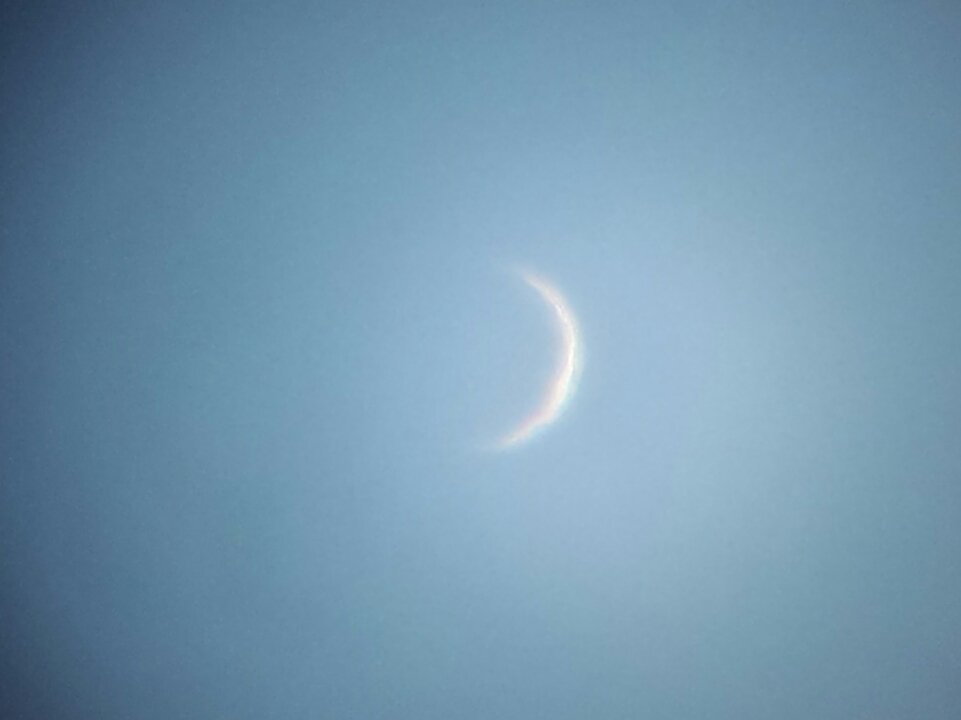
This image of the crescent Venus from August 12, 2015 was taken by holding a smartphone camera over the eyepiece of a telescope. (Chris Vaughan)
Welcome to the July Sky, Stargazers!
Here are your Astronomy Skylights for the week of July 2nd, 2023 by Chris Vaughan. Feel free to pass this along to your friends and send me your comments, questions, and suggested topics. You can also follow me on Twitter as @astrogeoguy! Unless otherwise noted, all times are expressed in Eastern Time. To subscribe to these emails please click this MailChimp link.
If you’d like me to bring my Digital Starlab portable inflatable planetarium to your school or other daytime or evening event, or deliver a session online, contact me through AstroGeo.ca, and we’ll tour the Universe, or the Earth’s interior, together! My terrific book with John A. Read entitled 110 Things to See With a Telescope is a guide to viewing the deep sky objects in the Messier List – for both beginners and seasoned astronomers. DM me to order a signed copy!
Earth will be farthest from the sun for 2023 on Thursday. Meanwhile, the moon will dominate the night sky. It will reach its full phase, while almost at supermoon status, but sitting very low in the sky, on Monday morning. Then it will rise later and wane in phase for the rest of the week. In the western sky after sunset, Venus will reach peak brilliance for this year’s evening appearance, with far fainter Mars and Regulus shining nearby. The gas giant planets will shine overnight. Read on for your Skylights!
We’re a couple of weeks past the June solstice now – so our nights will be lengthening at an accelerated rate in the Northern Hemisphere. This week, mid-northern latitude residents will trade about one minute per day of daylight for night-time. In a couple of weeks that rate will double! The moonlight aside, truly dark skies will begin at the end of astronomical twilight, which is about 11:20 pm local time, and end when the sky starts to brighten again at 3:20 am. A shame since there’s so much eye candy to enjoy during summer. In the next couple of weeks, I’ll showcase some sights to see later in July when the moon gets out of the way.
Earth at Aphelion
On Thursday, July 6 at 4:06 pm EDT, 1:06 pm PDT, or 20:06 Greenwich Mean Time, Earth will reach aphelion, its maximum distance from the sun for this year. The aphelion distance of 152.1 million km is 1.67% farther from the sun than the mean Earth-sun separation of 149.6 million km, which is also defined to be 1 Astronomical Unit or 1 A.U. Earth’s minimum distance from the sun, or perihelion, will occur on January 2, 2024. In a telescope equipped with a proper solar filter, the July 6 sun will appear a little smaller than it was in January.
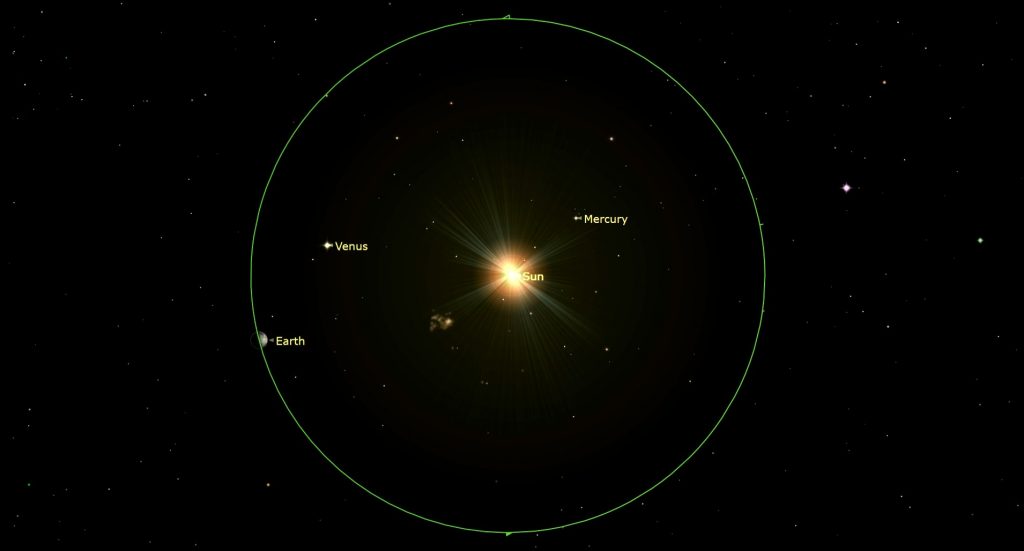
We can’t merely divide our 365.25-day year into four 91.3-day-long seasons. Planets in elliptical orbits move faster when they are closer to the sun and slower when they are farther away. Since Earth is moving slower at aphelion in July, summer in the Northern Hemisphere is 93.6 days long, or about five days longer than winter’s 89.0 days. Spring is 92.8 days long, leaving autumn at 89.8 days.
Our seasonal temperatures are not controlled by our distance from the sun. It’s the duration and intensity of sunshine we receive that makes the most difference – and that is controlled by the degree to which Earth’s axis is tipped toward (or away from) the sun.
The Moon
Earthlings worldwide will have one more week of bright overnight moonlight to experience before the stars return in their full glory.
Tonight (Sunday) the moon will look full when it rises in late evening in the Americas – but it won’t be quite there, yet. Binoculars or a backyard telescope will reveal some shadows among the craters along the western rim of the moon. The moon will formally reach its full moon phase – opposite the sun in the sky – on Monday morning, July 3 at 7:39 am EDT or 3:39 am PDT or 11:39 Greenwich Mean Time. By then the moon will already have set for most of the Americas, but Canadians and Americans in the Pacific Time zone will see the full moon setting in the southwest at sunrise.
Rewinding a bit to Sunday night, our natural night-light will be shining inside the Teapot-shaped stars of Sagittarius (the Archer). Full moons at this time of year shine low in the night sky because they sit opposite to the very high noon-day sun. While the sun and moon are positioned on opposite sides of the ecliptic, they behave like kids on a teeter-totter – when one of them is high, the other one is low. (Winter full moons are nearly overhead at midnight because the mid-day sun is so low.)

The moon’s orbit around Earth is tilted by about 5° from the ecliptic, allowing it to venture as much as an outstretched palm’s width above and below that imaginary circle across the sky. This month’s full moon will happen while the moon is at its farthest extent below (or south of) the ecliptic, 5.5°, which will place it well within the very southerly constellation of Sagittarius. When Sunday night’s moon climbs to its highest point in the sky, due south, around 1 am local time on Monday, it will barely clear the treetops! (In the Southern Hemisphere, that moon will shine nearly overhead.)
The extra effect of all this southerly wandering will be that the moon won’t be properly full anywhere on Earth. The terrain along a strip across the northern edge of the moon will still be casting shadows. Grab your binoculars or telescope and check out this peculiar phenomenon!
But wait – there’s more! We’re entering the supermoon period of 2023. Supermoons occur in consecutive groups or three or four – about every 14 months. During those periods, the moon’s 27.32-day sidereal orbital period that causes perigees and apogees temporarily aligns with the 29.53-day synodic period that produces the moon’s phases. An astrologer named Richard Nolle appears to have coined the term in 1979, and has refined it since then. His “definition” requires that the moon be full while it is also within 90% of its closest approach to Earth – or within about 360,000 km. Supermoons look about 16% brighter and 7% larger than average.
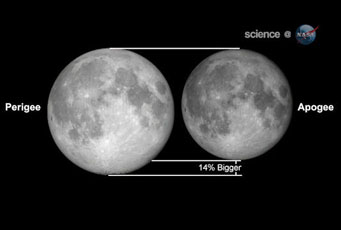
This full moon will occur about 1.5 days before perigee, making it slightly farther from Earth than is required to make it an official supermoon. But the spherical shape of the Earth will mean that people living at tropical latitudes will be just close enough to the moon for it to appear super-sized on Sunday night in the Americas. Two genuine supermoons – yes, two – will occur in August!
Don’t forget that any moon, even a supermoon, can easily be covered by a pinky fingernail held at arm’s length and one eye closed. That even applies to little children’s tiny fingers!
The July full moon, commonly called the Buck Moon, Thunder Moon, or Hay Moon, always shines in or near the stars of Sagittarius or Capricornus (the Sea-Goat). Every culture around the world has developed its own stories about the full moon, and has assigned special names to each one. The indigenous Ojibwe people of the Great Lakes region call this moon Abitaa-niibini Giizis, the Halfway Summer Moon, or Mskomini Giizis, the Raspberry Moon. The Cherokees call it Guyegwoni, the Corn in Tassel Moon. The Cree Nation of central Canada calls the July full moon Opaskowipisim, the Feather Moulting Moon (referring to wild water-fowl habits), and the Mohawks call it Ohiarihkó:wa, the Fruits are Ripened Moon.
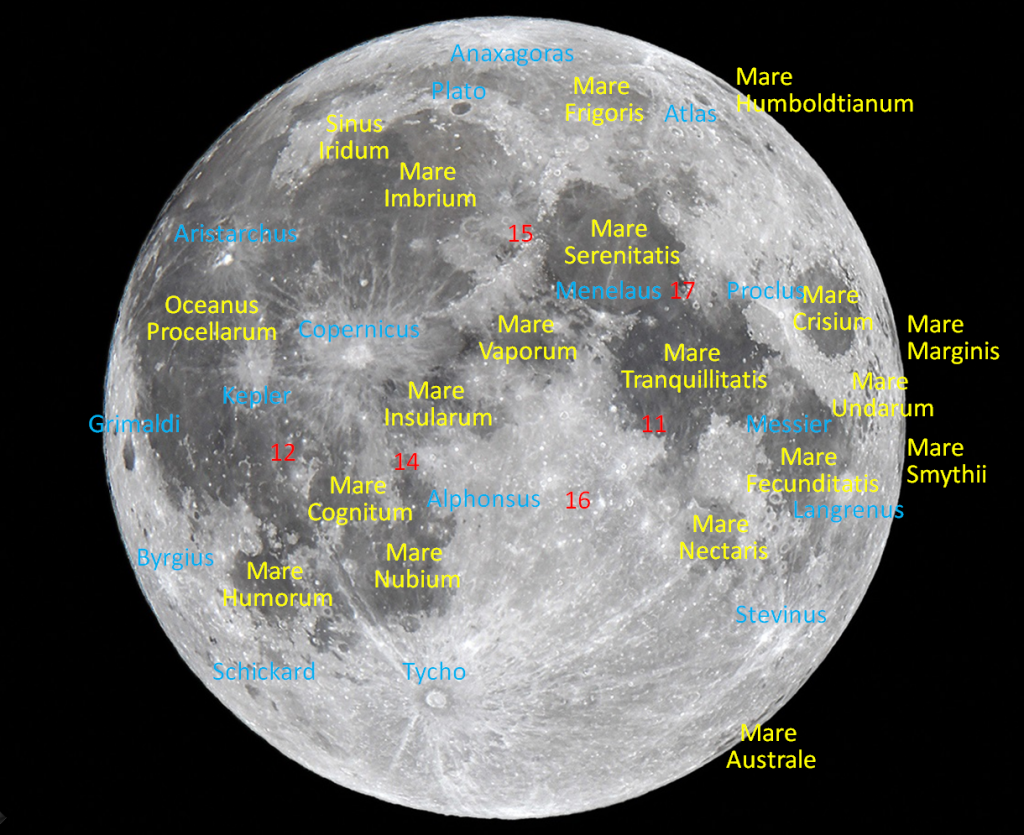
From Monday onward, the moon will wane in phase and rise about 50 minutes later each night. It’ll spend Tuesday and Wednesday passing through Capricornus (the Sea-Goat). Late on Thursday night, the waning gibbous moon will rise over the southeastern horizon accompanied by the prominent yellowish dot of Saturn and the stars of Aquarius (the Water-Bearer). Saturn will be positioned several finger widths above (or 3 degrees to the north of) the moon, close enough for them to share the view in binoculars. During the night the orbital motion of the moon and the diurnal rotation of the sky will shift Saturn to the moon’s upper right. Early risers on Friday morning can spot the duo in the southern sky at dawn.
On the coming weekend the moon will swim along the boundary between Pisces (the Fishes) and Cetus (the Whale) before dawn and then it will linger into the morning daylight sky. If you are outside early on Sunday morning, you can spot the half-illuminated moon shining between Saturn and bright Jupiter, which will gleam to the moon’s lower left.
The Planets
The planet Venus alternates between morning and evening apparitions every 584 days, or 1.6 Earth years. Because we are viewing our sister planet from a moving platform, the Earth, its appearances, or apparitions to use the astronomy term, are asymmetrical. Venus first enters the evening sky about 8 months before its greatest eastern elongation from the sun, and then it takes about 2.5 months to sink sunward (the stage we’re in right now). For morning appearances, Venus takes 2.5 months to reach its greatest western elongation away from the pre-dawn sun, and then 8 months to sink back into the predawn twilight – and so on. Venus will pass inferior solar conjunction, between Earth and the sun, on August 13. Then it will spend September and October increasing its distance from the morning sun and most of the winter dropping back again.

Venus is bright enough to cast shadows on moonless nights and to be seen in daylight when it is high in the sky. It ranges in apparent brightness from magnitude -4.9 to -3.8, which is almost a factor of 3. The sun and the moon are the only naturally brighter objects – unless a nearby star happens to go supernova one day. Venus’ intensity is mainly due to its proximity to Earth (as little as 41 million km) and to the high reflectivity of its cloud tops. It peaks in brilliance 26 days after its greatest elongation in evening and 36 days before its greatest elongation in morning.
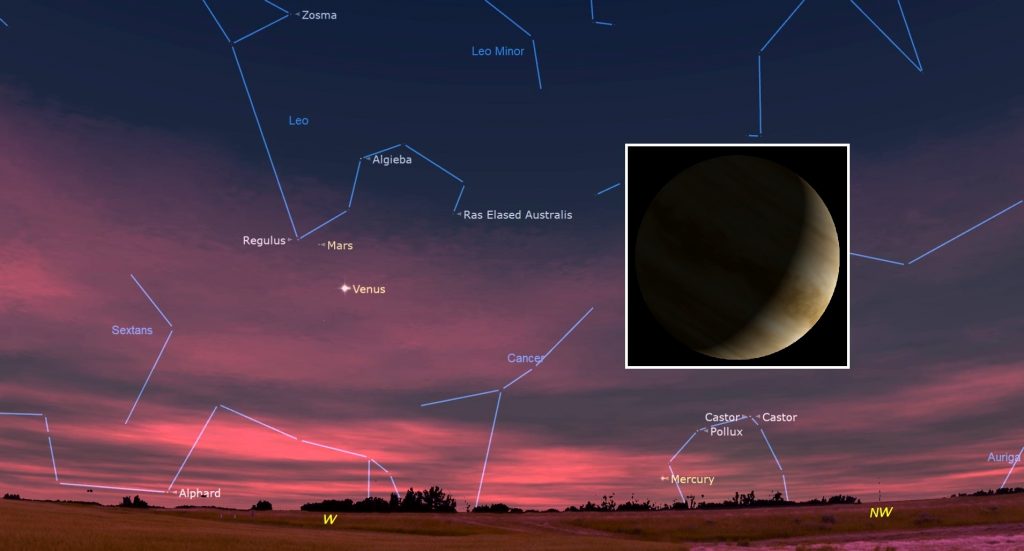
Venus’ greatest illuminated extent will occur this week on Friday. In a telescope, the planet will show a 26.4%-illuminated, waning crescent phase and an apparent disk size of 37.3 arc-seconds. Those numbers combine to produce the greatest illuminated area of the planet on the sky. Even with its less than fully-illuminated disk (inset), Venus’ distance from Earth of only 0.447 Astronomical Units or 66.86 million km will boost its brightness to that brilliant peak magnitude of -4.69. Don’t fret if Friday is cloudy. Venus will appear just as bright for several evenings. To see the planet’s shape most clearly, wait until the sun has fully set and then aim your telescope at Venus while the sky is still bright. That way Venus will be higher, shining through less intervening air, and her glare will be lessened. Good binoculars can hint at Venus’ non-round shape.
Venus will first appear in the lower part of the darkening western sky at sunset. Because it is dropping lower each night, you may need to walk around to position it between buildings or trees. Before long, Regulus, the brightest star in Leo (the Lion), will appear less than a fist’s width to Venus’ upper left. The far fainter, reddish speck of Mars will shine weakly about midway between Venus and Regulus.
Last Friday, the separation between Venus and Mars in the sky decreased to a minimum. From now on, their separation will increase as Venus drops sunward faster than Mars. Meanwhile, Regulus and the rest of the background stars will shift sunward a little each night – first towards and then passing Mars and Venus.
During March Ceres, the largest object in the main asteroid belt, passed close to several bright galaxies when its orbital motion carried it through the Virgo Cluster of Galaxies – setting up some nice photo opportunities. Now Ceres is travelling east again, although below (south of) the main cluster, and will again move close to some nice galaxies. Tonight (Sunday) and on Monday, telescope-owners can see the magnitude 8.65 minor planet, which is also visible in full-sized binoculars, positioned a thumb’s width below the large, bright elliptical galaxy Messier 49. You can find Ceres in the lower part of the southwestern sky after dark, a generous fist’s width to the left (or 11° to the celestial southeast) of the very bright star Denebola, which marks Leo’s tail, and a slim fist’s width to the right of Virgo’s less-bright stars Porrima and Minelauva.

The next planets don’t appear until late night. Saturn’s yellowish dot will rise over the eastern horizon just before midnight this week. The best time to view Saturn will be before dawn, when it will be located a third of the way up the southern sky among the modest stars of Aquarius (the Water-Bearer). Even a small telescope can show Saturn’s rings and some of its moons. Saturn will be available for our evening viewing pleasure through its opposition in late August and then on to mid-winter! The planet Neptune, 600 times fainter than Saturn, will be located two fist diameters to Saturn’s left, or 20° to its celestial east.
Jupiter will rise next, at about 2 am local time. Its brilliant white dot will look about 16 times brighter than Saturn. Jupiter will shine well above the eastern rooftops when the sky starts to brighten around 4:30 am, but you should be able to see the giant planet easily in the southeastern sky until almost sunrise. A couple of weeks from now, Jupiter will rise early enough to shine in a dark sky amid the stars of its host constellation, Aries (the Ram). It will become an evening planet by the second week of August. We’ll be able to view it from then until March, 2024.
Binoculars will show Jupiter’s four Galilean moons lined up beside the planet. Named Io, Europa, Ganymede, and Callisto, in order of their orbital distance from Jupiter, those moons complete orbits of the planet every 1.7, 3.6, 7.2, and 16.7 days, respectively. If you see fewer than four moons, then one or more of them is crossing in front of or behind Jupiter, or hiding in Jupiter’s dark shadow – or two of the moons are very close together or occulting one another. All four of them will huddle to the west of Jupiter on Thursday morning.

Even a small, but decent quality telescope can show you Jupiter’s dark belts and light zones, which are aligned parallel to its equator. With a better grade of optics, Jupiter’s Great Red Spot, a cyclonic storm that has raged for hundreds of years, becomes visible for several hours when it crosses the planet every 2nd or 3rd night. For observers in the Americas, that GRS will cross Jupiter’s disk on Monday, Wednesday, and Saturday morning. If you have any coloured filters or nebula filters for your telescope, try enhancing the spot with them.
Jupiter will be followed across the sky by Uranus, which will be positioned 1.2 fist diameters to the bright planet’s lower left (or celestial east). The magnitude 5.8, blue-green planet is visible in binoculars and small telescopes if you know where to look. It will become much easier to see in the coming weeks.
Some Moonlight-Friendly Sights
If you missed last week’s information about sights to see – with your unaided eyes, and through binoculars and backyard telescopes – when the moon is shining, I posted it here.
Public Astronomy-Themed Events
Every Monday evening, York University’s Allan I. Carswell Observatory runs an online star party – broadcasting views from four telescopes/cameras, answering viewer questions, and taking requests! Details are here. They host in-person viewing on the first clear Wednesday night each month. Other Wednesdays they stream views online via the observatory YouTube channel. Details are here.
On Wednesday evening, July 5 at 7:30 pm EDT, the RASC Toronto Centre will host their free, public, in-person monthly Recreational Astronomy Night Meeting in the Gemini East Room at the Ontario Science Centre. The meeting will also be live streamed at https://www.youtube.com/rasctoronto/live. Talks include The Sky This Month, the mystery of the Marsh Telescope, and an update on the Artemis Mission to the moon. Details are here.
My free, family-friendly Insider’s Guide to the Galaxy webcast with RASC National returns on Tuesday, July 4 at 3:30 pm EST. Delayed from June 20, we’ll focus on how to use star charts and which ones are best. Then we’ll highlight our next batch of RASC Finest NGC objects. You can find more details and the schedule of future sessions here.
Keep looking up, and enjoy the sky when you do. I love questions and requests. Send me some!